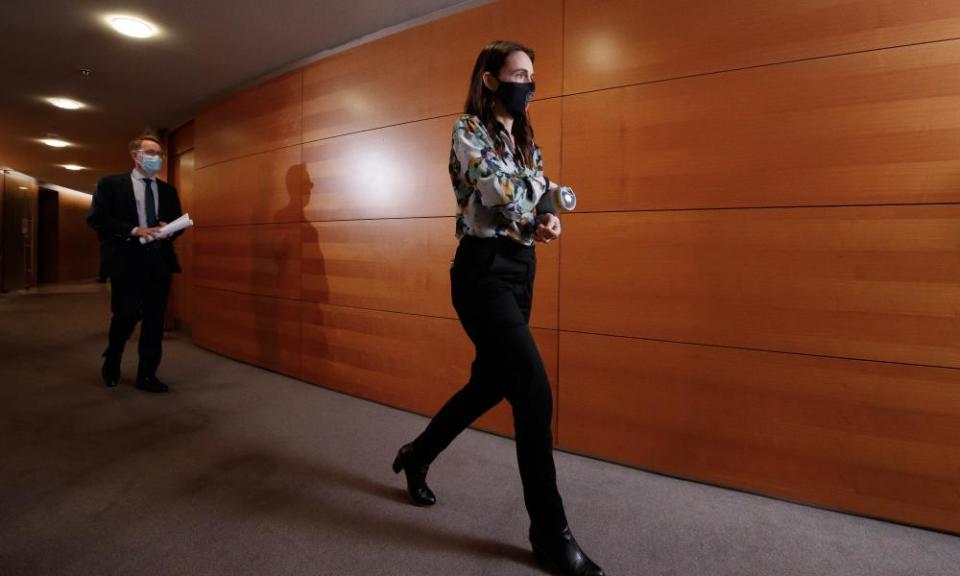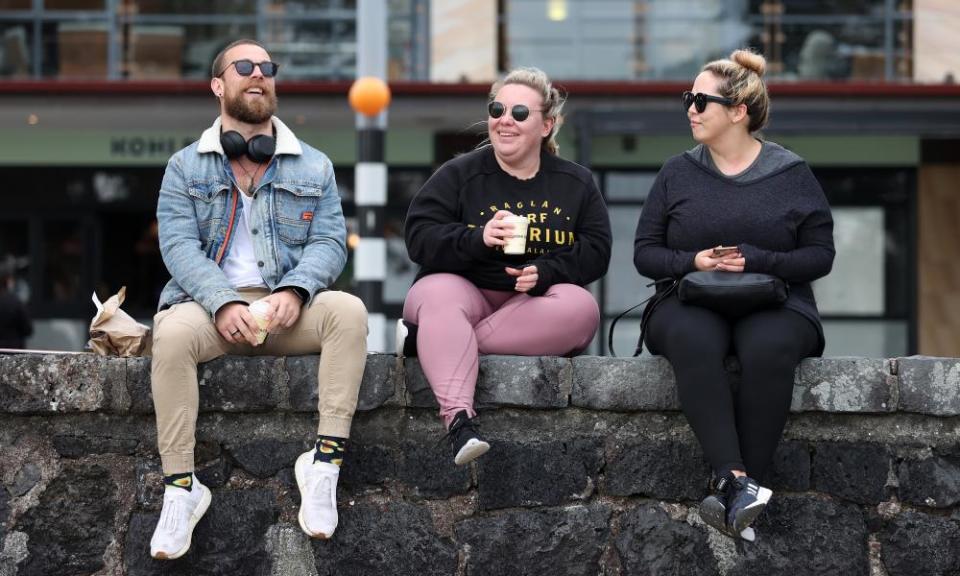‘Calculated risk’: Ardern gambles as New Zealand Covid restrictions eased

New Zealand is loosening its Covid restrictions, even as a handful of cases continue to circulate in the community, a move experts say represents a roll of the dice for a country that has steadfastly pursued an elimination strategy.
“It is a gamble,” says epidemiologist and public health professor Michael Baker. “The one phrase that I think you’ll hear all the epidemiologists and modellers use is ‘a calculated risk’. But of course that implies you have a number you can apply to it – you could actually call it an uncalculated risk.
“It increases the risk that we won’t contain the outbreak, but it’s hard to know what that increase is. That’s where good luck comes into it.”
On Monday, the prime minister, Jacinda Ardern, announced that Auckland would move out of its strictest lockdown, into alert level 3. It marks a significant shift in restrictions for the city: cafes and restaurants can reopen for delivery and socially distanced sales, as well as a number of other businesses, and small weddings or funerals can proceed.

The change will see an estimated 300,000 additional people return to work in their city workplaces – in commercial kitchens, over coffee machines, at the greengrocer or on building sites – and much of that workforce has particular vulnerabilities to the virus. Those working in hospitality skew younger, so are much less likely to be fully vaccinated, and many frontline workers are Māori and Pasifika, who are likelier to live in large households and are more vulnerable to serious illness from Covid-19.
While New Zealand has managed to significantly decrease cases from the outbreak’s peak of 83 daily cases in August, it has not yet managed to stamp them out completely. For the past week, infections have rumbled along at a daily average of 17 new cases a day. The country continues to have unlinked, or “mystery” cases that have not yet been connected to an existing infection. And because daily case numbers only provide a snapshot of the past – always showing people who were infected days prior – it’s impossible to be entirely sure whether Auckland’s outbreak has been successfully contained.
Related: Frustration for New Zealand returnees as Covid quarantine waiting list hits 30,000
“The outbreak may have been entirely stamped out by now – we just don’t know,” Baker says. “Or it could be simmering. These undetected chains of transmission could be simmering on.”
When Ardern announced the shift she said: “We are not stepping out of level 4 because the job is done, but nor are we moving because we don’t think we can achieve the goal of stamping out Covid-19 – we are moving because level three still provides a cautious approach while we continue to stamp out Covid-19.”
‘Stark choices’
But loosening restrictions while those cases are still lurking may be the biggest risk the Ardern government has taken yet in its pandemic approach, and the stakes are high. Now, the best-case scenario for New Zealand is that elimination works under level 3: that even with more people mixing in workplaces, infections still tail off, taking the country back to zero. If that doesn’t happen, and cases balloon in the coming weeks, Baker sees two options ahead: one is a return to level 4, which would be a huge political challenge for the Ardern government. The other is a pivot to suppression: using near-level 3 restrictions to keep the virus in check until vaccination levels are high enough – a point that he says the country is unlikely to reach before the end of the year.
“At the moment I think we do have these fairly stark choices between fully stamping it out versus not quite getting there, and going into this suppression approach for potentially a few months,” he says.
“We certainly do have to have an informed conversation in New Zealand at some stage about the conditions under which we would transition to suppression – assuming we get through this outbreak,” he says. “Because there will be a point.”
The director general of health, Dr Ashley Bloomfield, remains adamant that elimination is still Aotearoa’s goal. But speaking to RNZ on Wednesday, Bloomfield said case numbers may not return to zero. “We may not get back to zero, but the important thing is we’re going to keep finding any infections and basically continue to contact trace, test, isolate people so that we stop the virus circulating in the community, and that is the aim,” he said.
He said health officials were aiming to get to a vaccination rate of over 90%. “That’s absolutely our new means whereby we will be able to get back to the freedoms we had under level 1,” Bloomfield said.
Having 90% of the population immune is still likely months away. At this stage, 61% of the total population has had one shot, and 32% have had both. While the country has been vaccinating at a very high rate, rates peaked in August at about 90,000 a day and have been trending down to about half that. It’s still not known how easy it will be to reach the 90% milestone or beyond: government data indicates that among those who are yet to get a vaccine, 20% are unsure about it or will not get it.
Asked by radio host Mike Hosking what the next move would be if Auckland kept experiencing cases over the next two weeks, Bloomfield said: “Let’s cross that bridge when we get to it.”
A dose of luck
“At alert level three, it’s still possible to deal with the last remaining chains of transmission,” Baker says. “Unless you get unlucky.”
Relying on luck is a tough proposition when dealing with the Delta variant, which is far more infectious than the mutations New Zealand so effectively stamped out in the past. The country has been steadfastly committed to an elimination strategy, and any level of Covid in the community was intolerable. That strategy has served it well, preserving a strong economy, high employment, relative freedom and normalcy in-country, and very few deaths or serious illnesses from Covid-19.
New Zealand has been acutely aware of the worst-case scenario – an outbreak like the one in the Australian state of New South Wales, which started with a looser lockdown. It has produced thousands of cases and is now averaging 10 deaths a day.
Now, with a shift to level 3, New Zealand’s outcome hangs in the balance. “The next couple of weeks are crucial,” says microbiologist and science communicator Dr Siouxsie Wiles, “because it’ll be a week or so before we really fully understand just that little bit more opening up at level 3, what it does.”
She calls the loosening of restrictions “a calculated risk” – although not one she would have taken. “If it was my choice, I would be saying, level 4 for a little longer,” Wiles says. “[But] I’ve always been more cautious than the government has been.”
Both Wiles and Baker note that the government has access to finer-grained information – so may have a slightly different, more optimistic picture of how unlinked cases fit together, and how much spread to expect in the coming weeks. “I really hope they’re right, because obviously it’s going to be pretty demoralizing to have to move back up the levels,” Wiles says. “I guess we’ll wait and see.”
The challenge now will be both luck and compliance. After a month of lockdown, both the government and the experts are hoping New Zealanders will shrug off lockdown fatigue and make it through another fortnight of level 3 rules.
“I do believe that we can eliminate,” Wiles says. “I don’t want people to lose hope. If all of us do the right thing, there’s less chance of this getting out of control.”

 Yahoo Finance
Yahoo Finance 